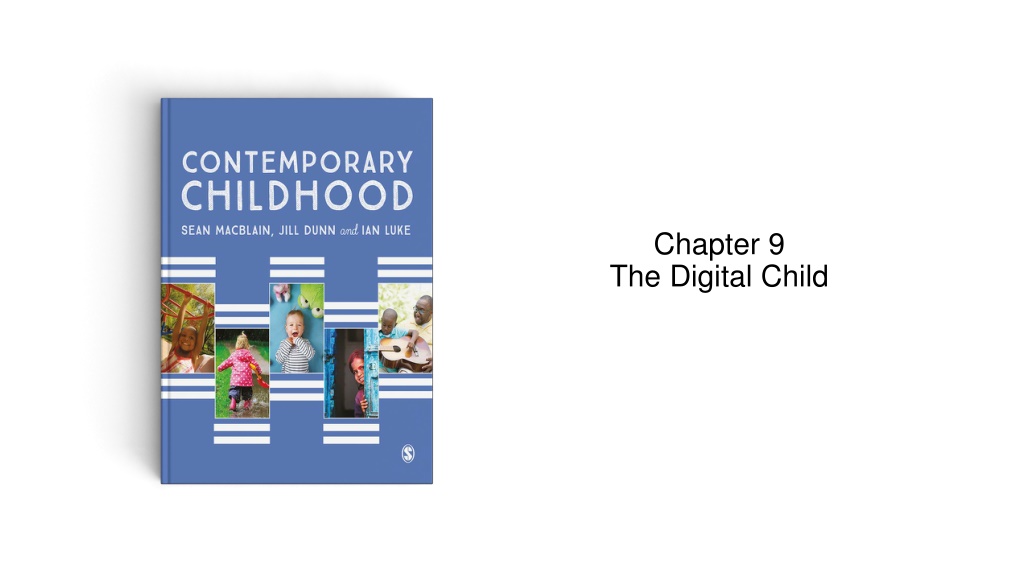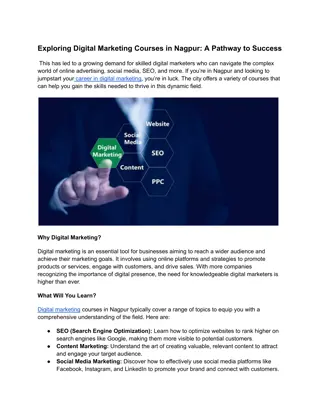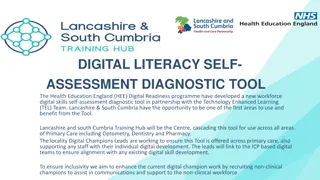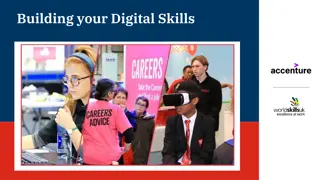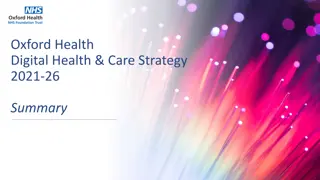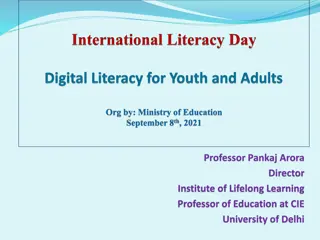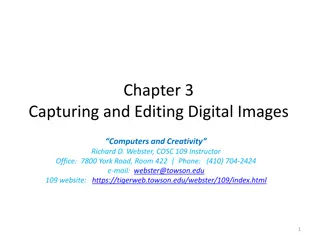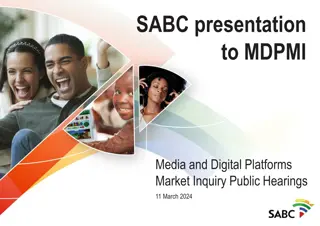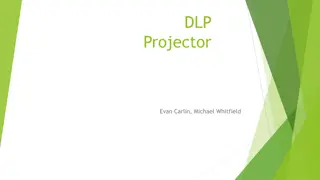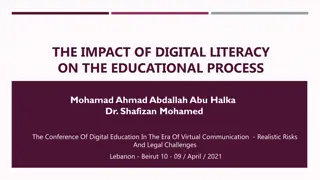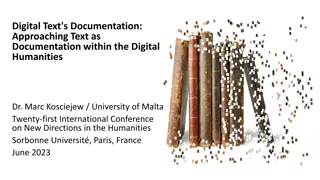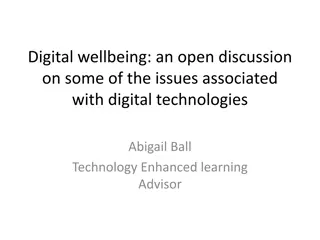Understanding the Impact of Digital Technology on Children Today
In today's digital age, children are growing up with easy access to technology, shaping their future employment prospects and educational experiences. Studies show a significant increase in screen time for young children, with a rise in the use of tablets and computers from a very young age. Despite the variety of digital media available, television remains a preferred and influential medium among children. Educators emphasize the importance of integrating digital technologies into school education to prepare children for the evolving job market requiring tech-savvy skills.
Download Presentation

Please find below an Image/Link to download the presentation.
The content on the website is provided AS IS for your information and personal use only. It may not be sold, licensed, or shared on other websites without obtaining consent from the author. Download presentation by click this link. If you encounter any issues during the download, it is possible that the publisher has removed the file from their server.
E N D
Presentation Transcript
Chapter 9 The Digital Child
The Digital Child Children today are looking towards a future which is unknown and many may work in jobs which don t yet exist. Along with the skills of creativity, critical thinking, flexibility and teamwork, having an ability technologies to locate communicate and collaborate will be crucial (Dudeney et al., 2013). A digital child may be described as a child who is living in a time and a culture where digital technology is readily available and widely used for everyday life including entertainment, education and communication. to engage with resources, digital information and
The Digital Child There has been a revolution in terms of the functionality and uptake of portable, networked technologies, and educators, in particular, are keen to capitalise on the potential application of such technologies for school education (Lynch and Redpath, 2014). Young children have been born into this new digital age and children are immersing themselves at younger and younger ages into new technologies (Teichert and Anderson, 2014). In a recent European study across six countries which explored children s and their families experiences with digital technologies, it was shown that digital technologies are an important part of children s lives but it is balanced with other activities such as outdoor play and non-digital toys (Chaudron, 2015).
Some figures In a recent survey of more than 1000 parents, it is reported that: time spent watching TV by children under 5 years has increased from 2.4 to 2.6 hours over the past year; 73% of under-5s are using a tablet or computer compared to 23% in 2012; Children are using tablets or computers by the age of 2 and when they reach 6 more than 40% of children are using them every day (ChildWise, 2015). Older children, aged 8 11, are also spending more hours per week online (10.5 hours in 2014 vs. 9.2 hours in 2013)(Ofcom, 2014). 65% of 3 7 year olds have access to a tablet computer and parents reported that children under 5 years used tablets for an average of 1 hour and 19 minutes on a typical weekday (Marsh et al., 2015).
Digital media Television TV has always been a hugely popular medium since its introduction in the 1930s. Ofcom (2014) reports that TV is the media activity that children aged 5 15 would prefer to do when given the choice and it is the media device they would miss most. They also report that it is the only media device used every day by the majority of children aged 5 15. However, there has been a decrease in the number of children having a TV in the bedroom. This recent data shows that TV, despite the growing range of other digital media devices, is still a very important medium for young children and they are spending a lot of time watching it.
Digital media Tablet computers A tablet computer (commonly shortened to tablet) is a small portable computer with touch screen technology and a pop up keyboard. Many have built in cameras and microphones and they are popularised by their user-friendly interface. In a recent European study, tablet computers were revealed as the favourite media device due to the size of their screen, their portability and their ease of use (Chaudron, 2015). Similarly Ofcom (2014) reported a significant increase in access to, ownership of and use of tablet computers by children of all ages with 70% of children aged 5 15 now having access to a tablet computer at home. It has been shown that the most common use for tablets is to play games, primarily for entertainment purposes (Livingstone et al., 2014). rather than educational
Digital media Smartphones A smartphone is a mobile phone with highly advanced features such as touch screen display, Wi-Fi connectivity and web browsing capabilities. Chaudron (2015) claims that smartphones are the melting pot devices as they are very versatile in their use, allowing children to watch videos, play games, send messages, take pictures, and make video calls and phone calls. ChildWise (2015) reported that 35% of pre-school children used a parent s mobile phone and Ofcom (2014) found that 40% of children aged 5 15 owned their own phone and this rose to 80% with children aged 12 15.
Digital media Social media Children s social media presence often begins before birth as parents share ultrasound images to announce the imminent arrival of a baby and the joys of early childhood are often shared on Facebook, Instagram, Flickr and elsewhere (Leaver, 2015). Facebook is the most popular social media site among 12 15s and their use of Instagram has doubled to 36% since 2013. A significant number of 12 15s also use other social media sites such as SnapChat (Ofcom, 2014). ChildWise (2015) reports that Facebook is slowly losing ground to Instagram and Snapchat and that vloggers (video bloggers) are the new media stars for the younger generation.
The affordances of tablet computers Many research studies refer to the novel features of tablet devices: they are portable and light-weight; they eliminate the need for separate input devices such as a mouse or keyboard; and they are designed to accommodate apps which have child-friendly, intuitive designs (Kucirkova, 2014). It is reported that, in contrast to traditional computers, touch screen tablets provide an easier to use and more intuitive interface for a child (McManis and Gunnewig, 2012). Neumann and Neumann (2014) discuss how touch screen tablets have the physical features to facilitate early literacy learning as they are book-like in shape and are in the form of a note pad that detects and responds to finger touch. Story-making apps enable children to incorporate sounds, images, text and design into their stories which can enhance children s creativity (Kucirkova and Sakr, 2015).
The importance of childrens experiences at home McTavish (2014, p320) highlights how adults have to grapple with how they integrate this technology into their lives but for young children born into this technological epoch, there is no choice; it is simply a way of being . More children and young people in 2013 reported that they read daily outside class and more reported that they read technology- based materials, such as websites, text messages, emails and instant messages. The proportion of children and young people reading e-books is also increasing (Clark, 2014a). 25% of children and young people reported they rarely or never write outside of class, but technology based formats such as text messages, social networking messages and emails are the most common formats of writing for those who do (Clark, 2014b).
Focus on theory The New Literacy Studies The New Literacy Studies takes a sociocultural view of literacy and is based on the view that reading and writing only make sense when they are studied in the context of social and cultural practices. Street (1997) proposed that any curriculum for literacy needs to capture the richness and complexity of actual literacy practices and give value to the different literacies that are employed in the home contexts. Children today are using technology-based formats of reading and writing as tools for building and maintaining social relationships, for getting things done and for deeply personal and internal purposes. In these social contexts, literacy has real meaning, relevance and purpose for children and failure to acknowledge this could result in schools being seen as irrelevant and archaic (McTavish, 2014).
E-safety for children in a digital world Social media plays a crucial role in children s everyday lives as they are the new, cool cultural hangouts, having replaced the street corner or public park of old (Evans, 2014, p154). Brindova et al. (2015) reported that watching television for more than three hours per day is correlated with adverse symptoms such as headaches, irritability and depression. Boniel-Nissim et al. (2015) showed there was a relationship between the amount of online communication and life satisfaction. More peer communication is experienced as positive up to a point but too much communication is associated with lower measures of life satisfaction. The ONS (2015) report on children s mental health and well-being in the UK highlights that children who spend more than three hours per day on social media sites are more than twice as likely to suffer poor mental health.
The role of parents in childrens e-safety Parents are reported as perceiving the opportunities for their children in using digital technologies but they also are concerned about the potential risks (Chaudron, 2015). Unwilling economic consequences, incidental inappropriate content, health and social impacts were all suggested as key concerns. In a similar study, parents were concerned about the following issues: a sense that this technology was out of their control; the damaging effects of instant gratification; children being so absorbed in the technology that they ignored those around them; violent, scary or gory content and strong language (Livingstone et al., 2014).
The role of parents in childrens e-safety Parents use a range of mediating strategies in relation to their children s use of digital technology such as setting time limits, having social rules such as no digital activity during dinner, having set places in the house for using devices, using content filters, supervision of their children and talking to their children about online safety. Some parents under-estimate the risks of the use of the technology by their children and there is a pressing need for greater parental awareness on potential risks and the development and promotion of communication strategies outlining how parents can talk to young children about managing online risks (Gray et al., 2017).
References Boniel-Nissim, M., Tabak, I., Mazur, J., Borraccino, A., Brooks, F., Gommans, R., van der Sluijs, W., Zsiros, E., Craig, W., Harel-Fisch, Y., Finne, E. (2015) Supportive communication with parents moderates the negative effects of electronic media use on life satisfaction during adolescence , International Journal of Public Health, 60(2): 189 198. Brindova, D., Dankulincova Veselska, Z., Klein, D., Hamrik, Z., Sigmundova, D. van Dijk J.P., Reijneveld, S.A., Madarasova Geckova, A. (2015) Is the association between screen-based behaviour and health complaints among adolescents moderated by physical activity? International Journal of Public Health, 60(2): 139 145. Chaudron, S. (2015) Young Children (0 8) and Digital Technology: A qualitative exploratory study across seven countries, Luxembourg: Publications Office of the European Union. ChildWise (2015) The Monitor Pre-School Report: Key behaviour patterns among 0 4 year olds. London: ChildWise. Clark, C. (2014a) Children s and Young People s Reading in 2013. Findings from the 2013 National Literacy Trust s annual survey. London: National Literacy Trust. Clark, C. (2014b) Children s and Young People s Writing in 2013. Findings from the 2013 National Literacy Trust s annual survey. London: National Literacy Trust. Dudeney, G., Hockly, N. and Pegrum, M. (2013) Digital Literacies. London: Routledge. Evans, S. (2014) The Challenge and Potential of the Digital Age: Young People and the Internet , Transactional Analysis Journal, 44(2): 153 166. Kucirkova, N. (2014) iPads in early education: separating assumptions and evidence , Frontiers in Psychology, 5(715): 1 3. Kucirkova, N. and Sakr, M. (2015) Child-Father creative text-making at home with crayons, iPad collage and PC , Thinking Skills and Creativity, 17: 59 73. Leaver, T. (2015) Researching the ends of identity: Birth and death on social media , Social Media and Society, 1 2, doi: 10.1177/2056305115578877.
References Gray, C., Dunn, J., Mitchell, D. and Moffett, P. (2017) Digital Technology in the Early Years Classroom: Developing the use of portable devices to support young children s learning. Belfast: Stranmillis University College. Livingstone, S., Marsh, J., Plowman, L, Ottovordemgentschenfelde, S. and Fletcher-Watson, B. (2014) Young Children (0 8) and Digital Technology: A qualitative exploratory study National Report UK. London: London School of Economics and Political Science. Lynch, J. and Redpath, T. (2014) Smart technologies in early years literacy education: a meta-narrative of paradigmatic tensions in iPad use in an Australian preparatory classroom , Journal of Early Childhood Literacy, 14(2): 147 174. Marsh, J., Plowman, L., Yamada-Rice, D., Bishop, J.C., Lahmar, J., Scott, F., Davenport, A., Davis, S., French, K., Piras, M., Thornhill, S., Robinson, P. and Winter, P. (2015) Exploring Play and Creativity in Pre-schoolers Use of Apps: Report for Early Years Practitioners. Available at: www.techandplay.org. McManis, L.D. and Gunnewig, S.B. (2012) Finding the Education in Educational Technology with Young Learners , Young Children, 67: 14 24. McTavish, M. (2014) I ll do it my way! : A young child s appropriation and recontextualization of school literacy practices in out-of-school spaces , Journal of Early Childhood Literacy, 14(3): 319 344. Neumann, M. and Neumann, D. (2014) Touch Screen Tablets and Emergent Literacy , Early Childhood Education Journal, 42: 231 239. Ofcom http://stakeholders.ofcom.org.uk/market-data-research/other/research-publications/childrens/children-parents-oct-14/. (2014) Children and Parents: Media Use and Attitudes Report. Available at: ONS http://www.ons.gov.uk/ons/rel/wellbeing/measuring-national-well-being/children-and-young-people-s-well-being-in-the-uk-- october-2015/art-insights-into-children-s-mental-health-and-well-being.html. (2015) Insights into mental health and well-being. Available at: children s Street, B. (1997) The Implications of the New Literacy Studies for Literacy Education , English in Education, 31(3): 45 59. Teichert, L. and Anderson, A. (2014) I don t even know what blogging is: the role of digital media in a five-year-old girl s life , Early Child Development and Care, 184(11): 1677 1691.
